Our processes. The experience of forming a support-team and a little about SMM
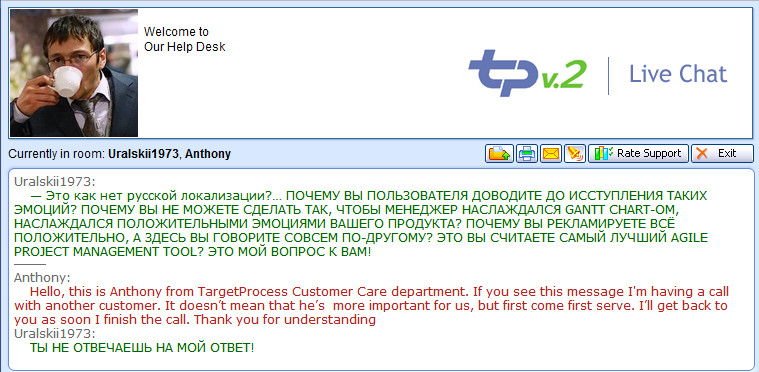
Continuing the theme “ Our development process: 50 months of evolution ”, let me tell you the story of the formation of our support-team.
Exposure and Disclaimer
Hello, my name is Anton (man-cup on the first snapshot), for the last two years I have been involved in building a team and setting up processes in the Customer Care Team. First, I will tell the story in the first person, because I really dislike faceless articles about how “our company instilled corporate values and formed a set of rules that helped increase the effectiveness of customer relationships, which allowed the company to reach new heights ". Secondly, the article is written in the Taucraft company blog, which allows me not to abstract from our flagship product TargetProcess , as well as our open-source tool - HelpDesk Portal (I, too, am too lazy to gloss over labels).
I will try to tell as honestly as possible so that you can also find here something useful for yourself. Thirdly, I really do not want to sacrifice interesting observations and various mini-themes for the sake of the beautiful and proper structure of the article. After all, as happens with modern authors (most often American), when one interesting thought comes - an entire book is being written. Therefore, I apologize in advance for some narration confusion: I do not want to give up minor, but, I think, important details (when editing forces me to cut something out of the article - it hurts me on a physical level, and the fact that the reader can eyes from a large number of snapshots, the author is less worried).
')
A bit of history

The founders of TargetProcess are strange: they did not go on “Startup Weekends”, they did not beat the thresholds of venture funds, they didn’t take mentors who, of course, will help open the doors to the world of global business and introduce you to some “right people”. They just took and for six months released a product that quickly received the Proof of Concept, and immediately the first feedbacks fell down. A start-up technical support team is not needed; the first customers carry the founders on their hands and fulfill all their whims and wishes. When a client’s wish can be realized in 2-4 days, it really makes an impression, and, as they say, such clients can become clients for life. Difficulties begin when a company has more than a hundred clients and it is simply impossible to fulfill all wishes (I wish all startups in the CIS have such problems). At this level, without the command of those. support is not enough.
People

Few understand how important it is to make the caliper personal and open. It is worth noting that events take place in Minsk, but 70% of clients are located in the USA and Canada. According to the Gartner agency, Belarus in the category “English proficiency level” always receives a stable rating “unsatisfactory” (but it is considered that there is a good education system here that makes highly skilled workers working cheaply).
The first people in technical support were inyaz graduates. But practice has shown that when a client’s problem is solved with an eerie Russian accent, it’s still better than when a client’s problem is not solved at all, but they apologize politely to correct English.
From the point of view of classical management, the technical support team is divided into three levels:
Level 1 - can find the answer to a frequently asked question.
Level 2 - can answer the question of increased complexity.
Level 3 - can solve any complex problem, most often for this you need the help of a programmer and code changes.
Most of our clients are professional programmers, and we do not need to respond to a large flow of requests (well, everyone knows how to use Google). In other words, in the team we need strong people to solve problems at the second and third level, but who only sometimes need to answer the questions of the first level.
Finding the right people is a really big problem. Firstly, we are not India (a very service-oriented country), there are practically no food companies that need technical support, and there are no ready-made people on the market either.
Standard job postings on job search sites did not help (I posted in the support and QA department). Non-standard solutions, infographics and a rather original vacancy in ZheZHE (I sometimes get the impression that, apart from Artemy Lebedev Studio and Alena Vladimirskaya, I don’t know how to describe a vacancy at all) helped a lot.
We offer salaries by 20-30% more than the average salary of an experienced QA-engineer in Minsk. Having spent about 20 interviews, I made only 2 sentences (I wanted my colleagues to have English better than me, but most of all I was upset that experienced QA read few books and do not even know how to use RSS). Basically, people refused, because they did not want to leave QA or automation.
Working 12 hours more than three months, I already started to panic and spent two days on weekends to send a personal invitation to every person in Minsk who had QA in their “My Circle” profile.
Luck smiled at us and Sergey came to us (an amusing vacancy in ZheZhe was shown to him by his wife, but he decided to react only after a personal invitation). He worked in a large corporation as a team leader (he taught former teachers computer skills) and brought many good system practices to the company.
Then Katya came, she worked for three years in those. support, and experience in the tourism industry helped her to acquire tremendous resistance to stress. She has smart English and always a good mood (people-catalysts are necessary for each team). Alexey worked as the head of the IT department at the National Academic Bolshoi Opera and Ballet Theater, but is better known as the creator of the popular in Belarus portal www.otryv.by (a game guide for the cities of Belarus and the near abroad). Not so long ago two more cool guys joined the team. Vyacheslav used to work in security systems, and his experience immediately proved to be a useful addition to the team’s moneybox. Anya has been engaged in supporting a complex system with heavy loads for the last couple of years. Her experience in working with clients from the CIS is extremely valuable, since requires some ... additional skills.
We also have a speaker Jonathan (working from an office in the USA), although he is more engaged in holding presentations and rarely helps us. Jonik usually laughs a lot when they say in the comments that he speaks English very well (in our time, people don’t expect to see a “native speaker” in those. Support).
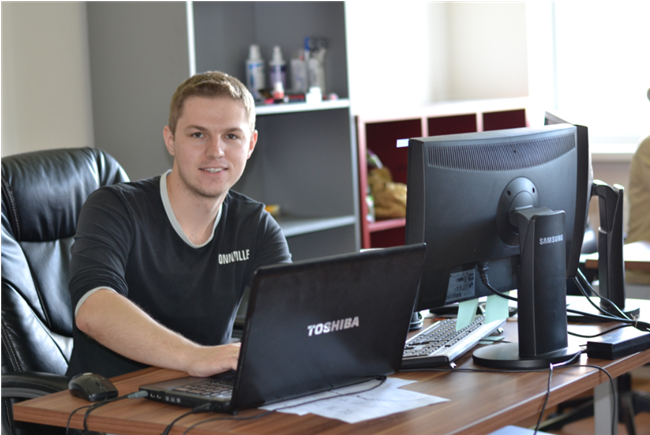
Sergey close-up, the new leader of customer care. Like me, I feel comfortable with only three monitors (on one I have TweetDeck, on the second Facebook, on the third for the decorum of something at work).
Instruments:
Emails
The main tool for working with clients is still communication through letters. When we receive a letter to support, we create a request (request) in our system, and the client receives a letter that “blabla, you are very important to us, the request number is such and such”.

We also sort queries based on keywords in the title.
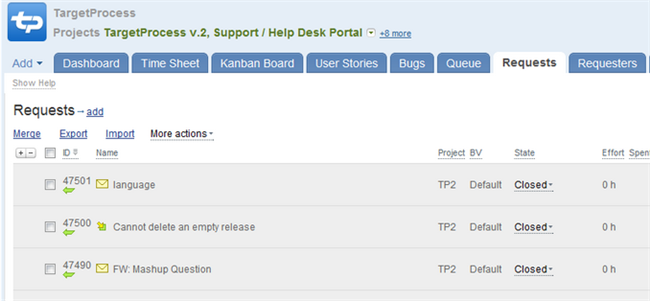
All requests fall into the so-called Requests List, but it is really inconvenient to use them for processing requests.
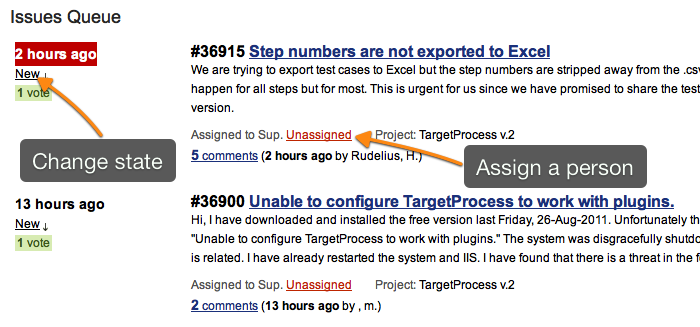
Therefore, we have created a special queue for processing requests (it is convenient to work when you create tools for yourself). Practice has shown that sorting by LIFO is more convenient. The logic there is this: the request is added to the queue (although in fact it is a stack), and after we answer it, the request from the queue disappears. If the client does not respond within two days, the request again enters the queue, and we duplicate the last message or ask if he is doing well. If after the second reminder the client does not respond, we simply close the request. When the queue is empty, we play table football, sit on Facebook or play MortalCombat on the Xbox (and when we get tired of doing nonsense, we start writing documentation).
Usually requests look like this.
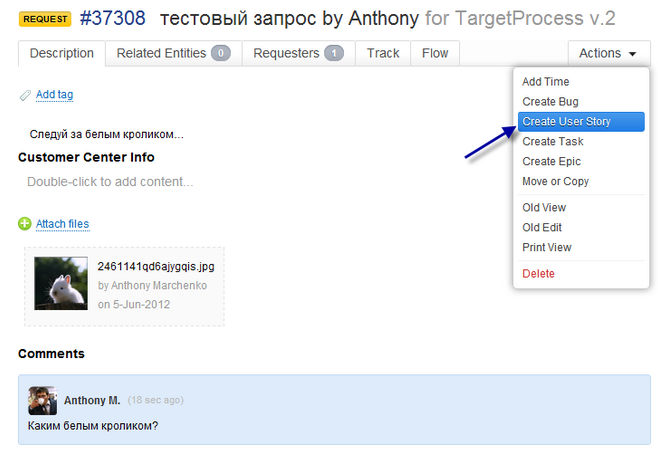
Sometimes we convert the request to the idea, not forgetting to thank for the feedback (the ideas are handled by the Product Owner). Or we create from request of bug, or there, we attach to existing user story.

According to our processes, except for the Product Owner, only the technical support team has the right to add something to the development process. When cards have different colors, in Kanban terminology, this is called Classes of Services. I mean, looking at our board, you can see that if there is a sup tag on the card, then this is a support task and it has its own color (I don’t know what it is called, let's say, card with color # ffecb3). So far we have only one dedicated programmer on the caliper (but we are looking for one more). When the blockage occurs, the so-called subbotnik is arranged, and the whole team deals with such tasks (it happens rarely).
Live Chat + gotomeeting
One of the most effective ways to interact with a client is to chat in an online chat. We use providersupport, which we, frankly, are not very satisfied (customers complain that it is buggy). If it becomes clear that using the online chat to solve the problem is difficult, we start gotomeeting, which allows you to see the customer’s problem with your own eyes, ask him for access to his computer and quickly “fix” everything or explain it to him.

Both on the website and on the SaaS version of the product there is an icon that will allow you to quickly contact us.
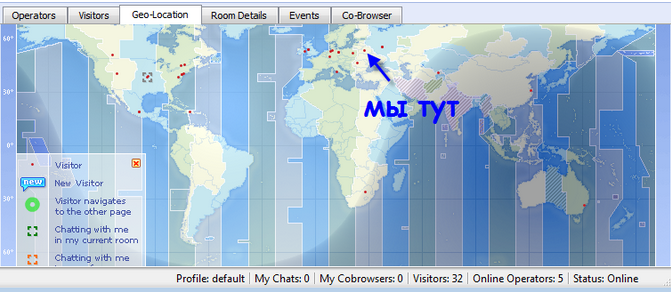
The providesupport I really like the tab geo-location, which allows you to find out where the client is calling from.
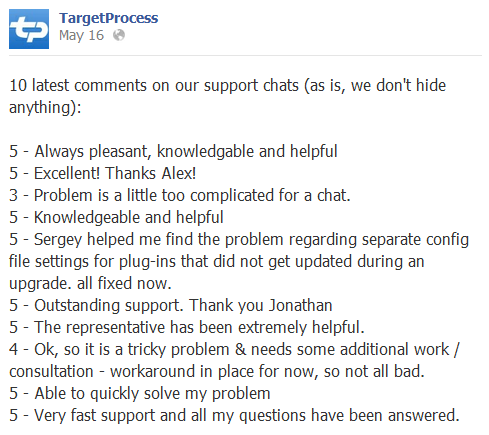
Post Chat Survey
Comments: Anna helped me quick, however I am not always a “good'n'smart” user. Thank you, and Anna. Regards, Tamas SZulman
Politeness: 5
Proficiency: 5
Post Chat Survey
Comments: I am just a new user, and Sergey helped fast, effective, polite. Respect, and thanks for a great team!
Politeness: 5
Proficiency: 5
Post Chat Survey
Comments: One of the best supports I have ever encountered. Twice already helped.
Politeness: 5
Proficiency: 5
It is also cool to get instant feedback from the client immediately after the completion of communication.
Post Chat Survey
Comments: Very slow and questions not answered.
Politeness: 3
Proficiency: 2
Approximately 90% of our customers rate our work as good and excellent (which is a very good indicator for the industry). But with baptism of fire, different situations are possible. We try to give maximum authority to employees for each team member and not to create narrow specializations.
Cultural differences
To be frank, we do not really like customers from the CIS. The main problem, probably, is the minimal use of such words as “hello”, “thank you”, “please”, “have a nice day” (I wrote about this in detail in the article “ 7 typical Russian problems in English speech .
It is clear that uncultured people are found everywhere, but it is a pity that the percentage of such people among our IT people is greater. We try to experience emotional involvement and always maintain a good mood, but, after you are nakamili, it is difficult to recover. If I had to organize a technical support department focused only on the CIS, I would probably go the other way and compile a list of standard phrases and patterns of patterned behavior when communicating with a client. In our country, everyone can answer as he sees fit. Maybe this is not quite true from a business point of view, but a person from technical support has the right to recommend to a complex client another project management system (in other words, to fire the client).
Even our young hackers from the post-Soviet space believe that if you find a small vulnerability in the product, then you need to write about this first in twitter, then on facebook, and then inform the technical support team. I think this is because our industry is still young and the general rules of etiquette have not yet been formed.
But something about me is sad, yet more than half of the clients from the CIS are very well brought up, and it is very pleasant to communicate with many: this is how I met many wonderful people.
Who to write documentation?
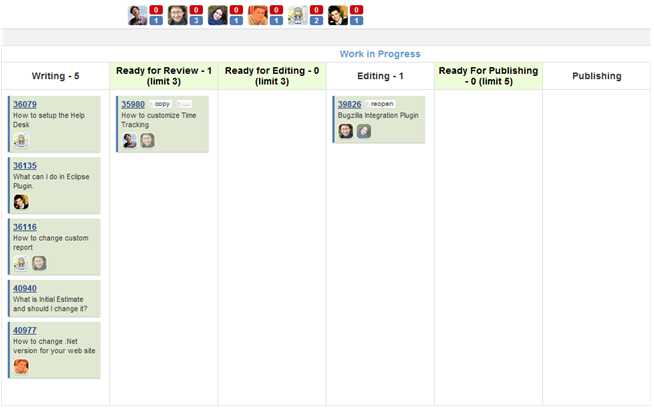
Nobody likes writing documentation. Personally, I insisted on hiring a specially trained person, but the CEO used to always write documentation himself, and now he decided that the technical support team would be involved. In indignation, I even wrote to the 37Signals team, but they replied that their documentation also wrote technical support.
Practice has shown that since technical support people communicate with customers most of all, it’s best for us to write documentation. Before that, we hired the “Native Speaker” in the USA to rule our “Russianisms”, but then it turned out that our marketing specialist Olya rules the texts not worse.
If in a good way, then we try to create such a product so that it does not need documentation. We can not do without documentation, but we have the competence to influence the product, and it is often better to simply solve problems with bottlenecks or take any preventive measures.
SMM (Social media marketing)
After SMM professionals from Israel were invited, the team had additional difficulties, because customers began to write anywhere.

In Facebook, we have 2400 likes, and during PR actions there were actively asking technical questions, which had to be answered and monitored. Fortunately, they write much less there now.

In LinkedIn, a community was created under our brand, where people began to actively write and discuss the subtleties of management.


The only thing we are constantly monitoring is twitter. We thought about creating a special account for the caliper, but since we usually respond personally, we use the main account.

That's all. Good luck to all, more good customers and a positive mood!
PS and one last thing
As they like to say in the TV shops, it is better to register right now (it takes 30 seconds). Yes, this is a dirty reception, but since August we will no longer provide a free On-Site version for up to 5 people (which you can host, the Help Desk is also provided free of charge). Instead, there will be a light version of SaaS (hosted on our servers), but there, unfortunately, there will be no support for the Help Desk (only in paid versions). So you have the opportunity to use a quality and free (rare combination) tool for organizing your small technical support team. We will support all available free versions while we are alive.
Source: https://habr.com/ru/post/146268/
All Articles